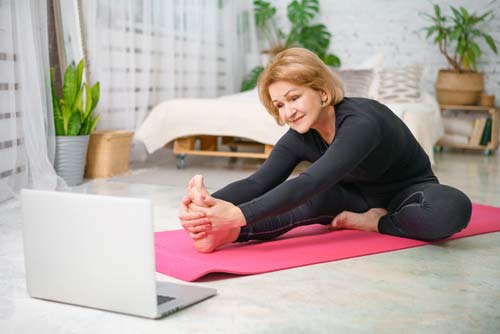How can I feel fit for everyday life?
Scientific support: Prof. Dr. Christine Joisten
Keeping fit in everyday life doesn’t necessarily mean regularly jogging, lifting weights, or playing tennis. On the contrary, every interval of physical activity, no matter how brief, has a positive effect on health, well-being and quality of life. Therefore, it’s essential to make your daily life as active as possible.

A long journey in small steps
One rule of thumb suggests walking 10,000 steps a day for a long and healthy life. However, it’s important to note that the scientific evidence for this recommendation is limited. Originally, this guideline came from a Japanese advertising slogan. Nevertheless, what’s clear is that every step counts, regardless of whether you’re increasing your daily steps from 2,000 to 2,500 or from 6,000 to 10,000.
Where does the rule of taking 10,000 steps a day come from?
This “magic number,” which has been circulating for a long time, does not originate from medical research, but from the advertising industry. After the 1964 Tokyo Olympics had captivated the people in Japan, a Japanese company capitalized on this wave of enthusiasm to market their pedometer named “Manpoke,” where “Man” stands for 10,000, “Po” for step, and “Ke” for counter. They advertised walking 10,000 steps per day because their device could record a maximum of that number of steps.
An analysis of several studies revealed that individuals under 60 years of age should ideally walk at least 8,000 to 10,000 steps daily. For individuals over the age of 60, their daily goal is already achieved with 6,000 to 8,000 steps. Walking this many steps per day is associated with health benefits and a reduced risk of mortality.
Good to know:
Each additional small step taken has a positive impact on health. Especially at the beginning of any increase in physical activity, the risk of developing type 2 diabetes, cardiovascular disease or even cancer decreases.
This step goal need not be achieved overnight and is not set in stone. Every step counts. Therefore, it is particularly helpful for untrained individuals to initially set a smaller number of steps as their goal. This also applies to individuals who, due to physical impairments such as being overweight or obese (adiposity), joint problems, heart weakness, back pain, or other complaints, may not be able to engage in as much physical activity. Setting smaller goals is easier to achieve and leads to a sense of accomplishment that motivates taking the next step.
Personal goals could, for example, start with 2,000 steps a day, which can then be increased to 3,000 steps over the coming weeks. This is a worthwhile objective since an additional 1,000 steps per day already reduce the risk of cardiovascular diseases and mortality. For people with diabetes, this is particularly significant because their risk of cardiovascular diseases is already elevated due to the diabetes condition. Therefore, anyone who can increase their daily step count by 1,000 steps not only improves their overall fitness but also reduces the risk of a heart attack or stroke.
Setting goals and getting started
Step 1: How many steps do I take on an average day?
Taking a gradual approach to your daily step goal is recommended. As a first step, it’s helpful to track your daily step count to determine how many steps you currently take in a day. For this purpose, devices known as “pedometers” are suitable: These come in the form of fitness tracker wristbands, pedometers that can be attached to clothing, or as apps on smartphones or smartwatches. Most smartphones already come with a pre-installed app capable of counting steps.
Step 2: In which situations can I incorporate more steps?
The second step toward achieving a daily step goal is already taken when you consider which routes you can easily cover on foot. Everyday activity begins with choosing to walk or cycle short distances instead of using a car and opting for stairs instead of an elevator.
A physically active day starts in the morning with the decision to park the car at the far end of the parking lot, adding a few extra meters to the walk to work. At the mall, office, or train station, using the stairs to reach the next floor instead of taking the elevator or escalator can increase your step count. Even climbing 1 or 2 flights of stairs contributes to your step total! Taking a longer route, for example, to the cafeteria, also adds to your step count. On the way home, consider getting off the bus or train one stop earlier and completing the rest of the journey on foot.
The trip to the grocery store, daycare, a friend’s or partner’s house, the pharmacy, as well as the journey to work, can perhaps be covered on foot or by bicycle instead of using a car, at least occasionally. In the evening, a walk can be a relaxing way to offset a stressful and eventful day.
Step 3:Sit less
Most of us spend several hours a day sitting, which can have negative health effects, even for those who engage in physical activity after a workday. It’s no wonder that the saying often goes: “Sitting is the new smoking.” But while smoking and sitting are not directly comparable, numerous studies have shown adverse health effects associated with prolonged sitting in daily life.
In Germany, people sit an average of 9.2 hours a day, and this trend has been increasing for years. Sitting typically begins at the breakfast table, continues in the car or on public transport, then at the office desk, in the doctor’s waiting room, or at the hair salon, and finally ends in the evening during dinner and, ultimately, on the couch.
It’s advisable not only to reduce overall sitting time but also to break up extended periods of sitting every 20 to 30 minutes with short standing or, even better, walking breaks.
For those working in an office, this could mean:
- Taking a short walk after a meeting
- Going to the kitchen for a tea break
- Bringing a document from the printer to a colleague
- Conducting brief meetings while standing or walking
- Making phone calls while standing
- Utilizing lunch breaks for a short walk or to run errands like going to the post office or dry cleaner can also be beneficial.
Additionally, investing in an adjustable desk, both in the office and for remote work, can be helpful. This allows for intermittent periods of standing while working, helping to avoid long periods of sitting that often lead to tension, headaches, backaches, and neck pain. Moreover, it increases overall activity levels. Standing naturally promotes more movement than sitting and engages different muscle groups. It relieves the typically hunched posture associated with sitting, and the knee joints are not held at a 90-degree angle for extended periods.
Another option is to interrupt desk sitting with a mini-workout at regular intervals (ideally every 30 minutes). This increases activity levels, strengthens muscles, and promotes flexibility.
Possible exercises include:
- Rolling shoulders forward and backward
- Stretching arms forward and alternately spreading fingers and clenching them into fists
- Sitting upright on the front third of the chair, extending legs and alternately flexing and extending the toes (calf pump)
Even when you’re not at your desk, taking breaks to move around is valuable for both your body and mind:
- Have the cup of espresso after lunch standing up instead of sitting down
- During TV commercial breaks, stand up and do small household chores
- Interrupting reading an engaging novel or magazine with a short movement break
- Incorporating a brief yoga or stretching session during a TV series
At home, some activities that are typically done sitting can be performed while walking: For example, phone calls or personal conversations might be more enjoyable during a walk than on the couch at home.
Once the body and mind have adapted to these new routines and volumes of activity, it’s possible to set the next step and movement goal.
An active lifestyle gets your whole body moving
Physical activity in daily life positively influences overall health, well-being, and quality of life. In particular, the combination of endurance activities like walking or cycling and strength exercises like carrying a crate of water or a full laundry basket in a back-friendly manner enhances numerous bodily functions:
- Lungs – “less puffing”
- Muscles – “more strength”
- Heart – “fewer palpitations”
- Blood vessels - “lower blood pressure”
- Immune system - “fewer illnesses”
- Bones – “stronger bones”
- Head – “thinking more clearly”
- Physical wellbeing – “feeling better”
Physical activity lowers blood sugar levels
Exercise improves insulin sensitivity in people at increased risk of diabetes and so reduces their risk of developing type 2 diabetes. This is especially important for people with prediabetes. During and after physical activity, body cells become more sensitive to insulin, allowing more sugar (glucose) to be taken from the blood into the cells. As a result, blood sugar levels decrease. An active daily routine and plenty of movement can lead to a permanent reduction in blood sugar levels for people with prediabetes, bringing them back into the normal range.
Movement also improves flexibility, coordination, and walking speed, enabling older individuals to better manage their daily lives and reduce the risk of falls.
Therefore, it’s advantageous to engage in sports activities beyond an active daily routine. For those inexperienced in sports, individuals with physical limitations, or those returning to exercise after a break, sports groups are highly recommended due to the professional guidance they provide.
Good to know:
And here’s some good news for those who have been relatively inactive until now: The less accustomed you are to physical activity, the quicker and more pronounced you’ll feel the positive effects of a slightly more active daily life.
Sources:
American Diabetes Association: Blood Glucose and Exercise. (Letzter Abruf: 18.09.2023)
Colberg, S. et al.: Physical Activity/Exercise and Diabetes: A Position Statement of the American Diabetes Association. In: Diabetes Care, 2016, 39: 2065-2079
Espeland, M. A. et al.: Effects of Physical Activity Intervention on Physical and Cognitive Function in Sedentary Adults With and Without Diabetes. In: J Gerontol A Biol Sci Med Sci, 2017, 72: 861-866
Froböse, I. et al.: Der DKV-Report 2023. Wie gesund lebt Deutschland? 2023
Hall, K. S. et al.: Systematic review of the prospective association of daily step counts with risk of mortality, cardiovascular disease, and dysglycemia. In: Int J Behav Nutr Phys Act, 2020, 17: 78
Joisten, C. et al. (2023): Mehr Bewegung im Arbeitsalltag. Fit und gesund im Büro und im Home-Office. Springer-Verlag, ISBN: 978-3-662-65983-0
Kyu, H. H. et al.: Physical activity and risk of breast cancer, colon cancer, diabetes, ischemic heart disease, and ischemic stroke events: systematic review and dose-response meta-analysis for the Global Burden of Disease Study 2013. In: BMJ, 2016, 354: i3857
Lee, I-M. et al.: Association of Step Volume and Intensity With All-Cause Mortality in Older Women. In: JAMA Intern Med, 2019, 179: 1105-1112
Paluch, A. E. et al.: Daily steps and all-cause mortality: a meta-analysis of 15 international cohorts. In: Lancet Public Health, 2022, 7: e219-e228
Rütten, A. et al. (Hrsg.): Nationale Empfehlungen für Bewegung und Bewegungsförderung. FAU Erlangen-Nürnberg, 2016
Scholl, J. et al. (2022): Diabetes zurück auf Null. 1. Auflage. TRIAS, ISBN: 978-3-432-11018-9
World Health Organization (2010): Global recommendations on physical activity for health. ISBN: 978-92-4-159-997-9
As of: 18.09.2023








